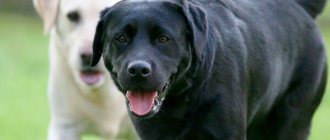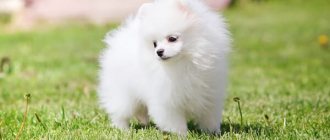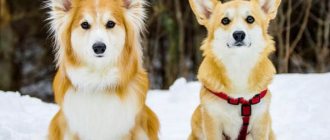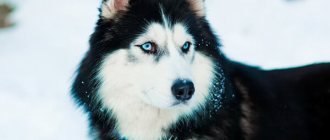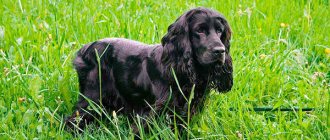The long-haired Malamute looks very impressive - in appearance, such a dog looks more like a large Spitz than a northern sled dog.
Thick and long hair, forming lush fringes, visually makes it even larger in size.
It is not surprising that such dogs are very popular all over the world.
However, future owners of long-haired Malamutes must take into account that their pet will not be able to participate in exhibitions and breeding.
After all, according to the breed standard, long hair for a Malamute is a serious drawback, which, however, does not in the least affect its working qualities or character.
History of appearance
Like other northern sled dogs, longhaired Malamutes are considered one of the most ancient breeds in the world. These dogs, which accompanied the ancient Eskimos, migrated to North America from Siberia 4,500 to 1,000 years ago. They got their name in honor of people from the Malmut tribe, who breed large and powerful dogs that resemble a wolf in appearance.
In ancient times, their ancestors were used for a wide variety of work. They helped people transport loaded sleighs and boats during river rafting, and also took part in hunting game of various sizes.
Living for centuries alongside people in cold northern climates, long-haired Malamutes have learned to adapt to harsh climate conditions.
However, after the breed was officially recognized, long hair in Malamutes began to be considered a breeding defect. Such dogs were excluded from breeding and were no longer allowed into exhibitions.
NOTE!
Although long-haired Malamutes are not intentionally bred in any breeding kennel, long-haired puppies continue to be born from time to time.
Interesting facts about Alaskan Malamutes
How did it happen that the breed of northern dogs became popular even where there is no trace of snow? This happened when they learned about Alaskan Malamutes in America, and it was thanks to the Americans that these amazing dogs spread throughout the world.
Why do these furry giants attract dog lovers so much? Let's get acquainted with interesting facts about Malamutes.
- Dogs of this breed starred in the famous film “White Captivity”.
- Malamutes are very hyperactive and simply love to dig in the ground, which is why they got the name shrews.
- Dogs cannot bark, but they love to howl. This quality was inherited from their ancestors.
- When you press on the pads of the paws, the claws of Malamutes come out, like those of cats.
- Dogs of this breed are excellent hunters and catch everything that moves.
- Malamutes do not grow up by one year, like ordinary dogs, but only by three years.
- Northern dogs do not like to swim and do not tolerate heat well.
As you can see, these are not only cute, fluffy giants, but also real descendants of the Arctic wolf, who have firmly entered the hearts of dog lovers and settled there forever.
Photo and description of the variety
The long-haired Alaskan Malamute is distinguished by its large stature and strong bones. He has considerable strength and endurance, allowing him to carry heavy loads. But at the same time, such dogs are not designed for speed racing, like, for example, faster and more agile huskies.
The long-haired Malamute has a rather wide and massive head with a marked transition to the muzzle. The ears are slightly rounded at the ends, triangular, erect, and widely spaced. The eyes are small, almond-shaped, set slightly obliquely. The expression of the gaze is calm, phlegmatic and friendly.
The body is almost square in format - the height at the withers is 1-2 cm less than the length of the body. The muscles are well developed, the chest is moderately wide and deep. The paws are massive and strong. The tail is of medium length, covered with very thick and fluffy hair. Usually, it is thrown on its back and is shaped like a lush plume or fan.
The color can be any of the intermediate shades between light gray and black, as well as reddish or sable. In this case, it is necessary to have an undercoat - lightening the fur to white on the face, forehead, neck, chest, lower part of the body, on the hind legs and on the tail. Of the monochromatic colors, only pure white is found in Malamutes.
IMPORTANT!
The appearance of the long-haired variety of Malamute should completely coincide with the external characteristics of standard dogs, except for the fact that their hair is longer.
Nicknames for dogs
The dog must respond to its name, this is also one of the commands. The nickname should be short and easy to pronounce, so the pet will remember it easier. Choosing a name for an Alaskan Malamute should be approached with all responsibility. Experienced dog handlers advise:
- When choosing a nickname, you should take into account the size of the pet. A diminutive for a big dog sounds ridiculous.
- Malamutes can be called by color: Sable, Red, Black.
- The nickname can reflect the harsh natural conditions in which the Malamute lives: Hurricane, Snowball, Buran.
- Nicknames for boys can be borrowed from films, toponymic terms: Viking, Oscar, Brutus, Kazbek, Nord, Danube.
- Nicknames for girls are usually chosen so that there are two syllables that go well together: Dina, Eva, Lizzie, Rada, Nora.
The name of an animal cannot be changed at will. It is given once and for all.
Character traits
The long-haired Malamute is a calm and even phlegmatic dog, distinguished by high intelligence and quick wit.
They treat people very kindly, which makes it difficult to use them as guards. True, the long-haired Malamute looks impressive and, thanks to its “wolf” appearance, can scare away an intruder with its appearance alone.
Long-haired Malamutes are protective of children and can even look after babies . This feature is fixed at the genetic level, because when the ancestors of modern Malamutes lived in Alaska with people from local tribes, they looked after children in the same way while their owners were busy with other things.
These dogs have a special attachment to their owners, which is also due to the habits they have developed over the centuries. After all, only through close interaction with people, the ancestors of Malamutes could survive in the wild nature of Alaska.
However, it must be taken into account that these dogs can be aggressive towards small pets and birds.
The fate of the extinct Hinmann-Irwin (or Hinman-Irwing) line
Kayak Of Brookside , male, born approximately 1940
(Hinman's Alaska x Mayos Nome) The dogs of the Hinman-Irwin line had a significant influence on M'Luth, being completely absorbed into that line.
The Husky-Pak kennel, whose dogs were widely used in the breed, first infused their M'Loots with the blood of the Hinman-Irwin line, and then mated the resulting M'Loot offspring with a purebred Kotzebue male. Father M'Luth, mother Hinman-Irwin.
CH Spawn's Alaska , born 09/07/1946
(Koyuk x Kiska) - 2-time winner of Westminster in 1951 and 1953. He had a great influence on the breed through his descendants at the Husky-Pak nursery, where only 1 litter was obtained from him. Spawn's Alaska children:
| Male CH Apache Chief Of Husky-Pak , ROM, 06/07/1948 (CH Spawn's Alaska x Chitina 1) | Bitch CH Arctic Storm Of Husky-Pak , ROM, 06/07/1948 (CH Spawn's Alaska x Chitina 1) |
Features of wool and its structure
The main feature of this variety, which distinguishes such dogs from standard Malamutes, is their long and thick hair .
Like other northern sledding breeds, their hair is two-layered, creating an air gap between the hairs, thanks to which fluffy malamutes tolerate low temperatures well and can sleep right in the snow.
Their guard hair is quite coarse and thick, and the undercoat is softer and fluffy. Both the awn and the down have different lengths in certain areas of the body. The hair is short on the ears, head and muzzle, as well as on the front of the paws. On the sides it reaches medium length, and on the neck, shoulders, tail and back of the limbs it forms lush feathers.
The paws of a long-haired Malamute visually look much thicker and more massive than they actually are due to the thick, long hair covering them.
Expert opinion
Kozhevin Semyon Kirillovich
Expert dog handler.
“According to the breed standard, the Malamute's coat should be quite coarse and not too long. However, despite the fact that long-haired individuals have not been involved in breeding for a long time, such puppies continue to be born. Researchers suggest that the long-haired gene is an inheritance inherited from modern Malamutes by their ancestors, when people bred dogs solely for their working qualities. Externally, long-haired Malamutes are very similar to standard representatives of the breed. They are quite strong, resilient and at the same time friendly towards people, and caring for them is no more difficult than standard Malamutes.”
Origin of the breed
The history of the breed is connected with the life of the ancient Malamute tribe. These are the native people of Alaska who were engaged in hunting and fishing. They bred these strong and hardy animals for their needs. At the end of the 19th century, this dog breed was on the verge of extinction. When the gold rush began, prospectors indiscriminately crossed Malamutes with smaller breeds. The number of purebred Malamutes has decreased sharply. The situation was leveled out only in the 20s of the 20th century, when American dog handlers began to actively renew the breed.
During the war, the number of representatives of this breed again decreased to a critical figure: experts counted 30 individuals. In the post-war period, measures were taken, as a result of which the population not only recovered, but also received worldwide recognition. In 1966, the International Canine Federation approved the breed standard for the Alaskan Malamute, which is still valid today. Currently, Malamutes are among the twenty most sought-after dogs in the world and are a symbol of Alaska.
Initially, the Malamute was intended to guard homes, transport goods and participate in dog fights. Gradually, the fighting and guarding qualities of this breed were lost, and it became exclusively a sled dog.
Advantages and disadvantages
Pros:
- They are distinguished by endurance and physical strength.
- They look impressive and quite unusual.
- Smart.
- Friendly towards people.
- Loyal to the owners.
- They treat children well.
- Calm and balanced disposition.
- They do not have the habit of howling when left alone.
Minuses:
- Dominant towards other dogs.
- Can be aggressive towards small animals or birds.
- Not suitable for protecting a house or apartment.
- Needs a lot of physical activity.
- It is considered a breed defect and is not allowed for exhibitions or breeding.
- Has a tendency to dig up the earth.
NOTE!
A long-haired Malamute usually sheds heavily, which makes caring for it somewhat more difficult.
Mating
According to experienced dog breeders, mating of Malamutes should occur when the male is 24 months old and the female is 20 months old. It is not recommended to breed dogs at a younger age, as this is a big burden for their fragile bodies. Knitting can be freestyle or manual. With freedom, the process occurs naturally. If the bitch is inexperienced, the dog owner helps them by first putting a muzzle on the bitch.
During pregnancy, physical stress on the bitch should be reduced. To give birth to puppies, you need to prepare a place for the dog and let her get used to it. At the moment when labor begins, you need to be close to the dog, distract it, and surround it with affection. Once the puppies arrive, it is best to leave the bitch alone. After the birth of the offspring, it is also better not to approach them at first. The mother should be allowed to feed and wash the puppies in peace. Then it will be possible to toilet the dog and examine the puppies.
Life expectancy and health
The life expectancy of these dogs is 13-16 years.
Longhaired Malamutes are generally in good health, but they may be predisposed to the following diseases:
- Congenital pathologies of the heart or kidneys.
- Dermatitis.
- Diabetes.
- Dysplasia.
- Volvulus of the stomach or intestines.
- Cataract.
- Obesity.
- Progressive retinal atrophy.
- Eczema.
- Epilepsy.
Basic rules of care
The dog's coat needs to be brushed 2-3 times a week, and every day during the shedding period. At the same time, it is important to comb not only the guard, but also the undercoat.
The long-haired Malamute does not need to be washed often: 2-3 baths a year are enough for him, especially since the dog itself is very neat, and its fur does not get too dirty.
The ears should be inspected every day and if dirt appears, cleaned with cotton swabs. The eyes also need regular examinations and cleaning when necessary. The eyes of long-haired Malamutes are wiped with a cotton swab dipped in a special composition or in a decoction of chamomile.
The dog usually brushes its teeth while eating solid food. You can also give your pet chewing cartilage or treats designed to clean it. If this does not lead to the desired result, you should additionally brush your pet’s teeth with a brush and toothpaste for dogs.
Claws, if they do not wear down during walks and training, need to be trimmed as soon as they begin to bend inward.
IMPORTANT!
During the shedding period, it is advisable not just to comb your pet with a comb, but to use a special brush for shedding dogs or a furminator.
To what age do they grow?
Like puppies of other large breeds, Malamutes are characterized by rapid rates of development . Their skeleton develops especially quickly during the first months of life and by 7-8 months the puppy acquires the size of an adult dog.
The formation of the musculoskeletal system ends by the age of 1, but the dog’s development continues - its figure is formed, its chest is enlarged, muscle mass is built up.
This process can last for several years and depends on the quality of nutrition, regularity, quantity and activity of walks and a number of other factors.
How and what to feed?
You can feed your long-haired Malamute either prepared food or natural food.
Moreover, if the dog eats homemade food, about a third of its diet should be meat or offal. It must be accompanied by boiled or raw vegetables, fermented milk (cottage cheese, natural yogurt, kefir) and a little rice, buckwheat or oatmeal.
If a dog is fed dry food, it must be of high quality and suitable for the pet’s age, size, physical condition and activity.
You should not give your long-haired Malamute food from your table, or feed your pet between feedings.
If the food method is used when training a dog, then the amount and calorie content of the treats he eats at the training site must be calculated from the daily diet.
Content
The best way to keep a Malamute is an aviary in the courtyard of a private house. Keeping a dog in an apartment is possible, but not advisable: the Malamute needs space and daily long stays in the fresh air. You can build an enclosure with your own hands or purchase a ready-made one. A booth is installed in it; its dimensions depend on the size of the dog. In general, it is recommended to adhere to the following parameters:
- the booth is built 80 cm high and 100 cm long;
- the height of the entrance hole should be 5 cm less than the height of the dog;
- The width of the entrance should be 5 cm wider than the dog's chest.
The enclosure for a Malamute should not be closed; the dog feels lonely in it. In such cases, she begins to howl. To wean your Malamute from howling, you need to leave him alone as little as possible. You can put something in his enclosure that smells like home and his owners, so that he won’t feel so sad about staying in the cage at night. Sometimes dogs howl from excess energy that has nowhere to be spent. In such cases, you need to increase physical activity on your pet. The main building material for building an enclosure should be wood, since Malamutes are very sensitive to toxic components of plastic and paints.
Nutritional Features
The Malamute's diet does not depend on its size. The huge dog eats less than representatives of other similar large breeds. At home, it is preferable to feed the dog natural food. The diet of a puppy and a dog should mainly consist of meat, cottage cheese, sometimes fermented milk products, cereals, chicken eggs, and vegetables. If it is not possible to prepare natural food, it is recommended to use dry food. This is better than feeding the dog dishes from the master's table.
Experts recommend feeding your dog twice a day. Eating one meal at a time can lead to volvulus. 4-month-old puppies are fed three times a day, from this age they are transferred to two meals a day. A dog always needs clean water.
Dog owners know that Malamutes have a bad habit of stealing food. To avoid health problems for your pet, you need to get rid of it.
How to choose a puppy?
to purchase such a puppy from a nursery or from a breeder, however, the metric will include a mark about the breeding. True, nowadays you can see many advertisements for the sale of long-haired Malamutes without documents.
CAREFULLY!
Buying a puppy without documents about its origin is fraught with many risks, ranging from the fact that it turns out to be a mixed breed and ending with serious problems with its health or psyche.
When choosing a future pet, you need to pay attention to its appearance, character and activity.
The baby should have a moderately large head, fairly massive, short paws, a compact body, a flat back and a thick, fluffy coat. Ears and eyes are clean, skin without signs of inflammation or scratching. By nature, he should be calm, but at the same time quite active, playful and friendly towards people.
M'Luth by Paul Walker
In the twenties, at the same time that Eva Seely was looking for dogs for her Chinook Kennel (Kotzebue Line), Paul Walker was buying dogs for his in Michigan, known as the M'Loot Kennel.
The Malamutes from the M'Loot kennel were of various origins: some dogs were purchased in Alaska, some in Montana, others from Minnesota, two females were purchased from a litter of white Canadian Eskimo dogs.
Due to differences in the origin of the dogs, a greater variety of colors was observed in the M'Loot phenotype. Kotzebue's line included only gray and white dogs. M'Loots ranged in color from black and white to silver gray and white, and even pure white. The M'Loots were larger and taller than Kotzebue. But what made the M'Luths and Kotzebue in common was their thick, straight hair, a fluffy tail that developed over their backs like a plume, and straight ears.
Paul Walker's M'Loots became very popular and huge numbers of dogs were sold throughout North America. His motto was: “The finest specimens of excellent breeding will make excellent companions for everyone from northern Alaska to sunny Florida.”
M'Lutami was studied not only by Paul Walker, but also by other kennels, who used them as foundation dogs for their kennels, and also subsequently registered dogs of the M'Lut line.
Mikiuk , born approximately 1945, 12 years old in photo (Tobuk I x Kapuk)
The Silver Sled kennel, Silver Sled, acquired the malamute Mikiuk from Paul Walker, crossed it with Noma and got champions: the son Mulpus Brook's Master Otter (the first champion malamute who became a prize-winner in the group) and the daughter Oolu M'Lut (the first American Champion - female among Alaskan Malamutes).
| CH Ooloo M'Loot - the first Malamute female - American Champion, her height is 61.5 cm, weight 38.5 kg, 02/27/1946, (Mikiuk x Noma) | CH Mulpus Brook's Master Otter , male, 02/27/1946 (Mikiuk x Noma) - littermate of the female CH Ooloo M'Loot. |
She (Oolu M'Lut) formed a pair with Nanuk, this pair was important for breeding the breed, because they gave the world champions Nanook II and Giana, whose numerous offspring were distributed to various nurseries and whose blood is present in real Malamutes...
CH Nahnook II , ROM (gray-white) and his sister Gyana (black-white), 07/09/1947 (Nahnook I x CH Ooloo M'Loot)
| СH King M'Loot , male, 02/22/1946 (Mikiuk x Fox M'Loot) | Moosecat M'Loot , male, born around 1940 (Mikiuk x Unutkook) |
Another breeder who carried the M'Loot line was Jean Lane, owner of Mulpus Brook Cattery. Malamute Mulpus Brooks The Bear, born in her kennel, became the first malamute to take 1st place in the group in 1954.
| Tonga , female, born around 1940 (Gentleman Jim x Tosha), was not registered with the AKC, because did not meet the norm: about 10 descriptions from exhibitions were required for registration. | Her son CH Prairie Lash , 06/27/1947 (CH Mulpus Brook's Master Otter x Tonga) | And her daughter Shawnee Belle , 06/27/1947 (CH Mulpus Brook's Master Otter x Tonga) |
From the mating of brother and sister, the female CH Baloo , 08/14/1950 (CH Prairie Lash x Shawnee Belle)
She in turn was bred to her uncle - CH Mulpus Brook's The Bear, and the female Kobuk's Dark Beauty , ROM (11 champions), 12/28/1953 was born (CH Mulpus Brook's The Bear x CH Baloo). Her son Sno-Crest's Mukluk became the first Alaskan Malamute to win Best in Show in America. Unfortunately, this beautiful bitch turned out to be not only a good producer, but also a proven carrier of chondrodysplasia, a disease that spread through the breed through her descendants, in particular her son Kodara Kodiak of Erowah, and daughter Sno-Crest Aurora of Erowah, as well as their son Ch. Erowah Cinnaman.
